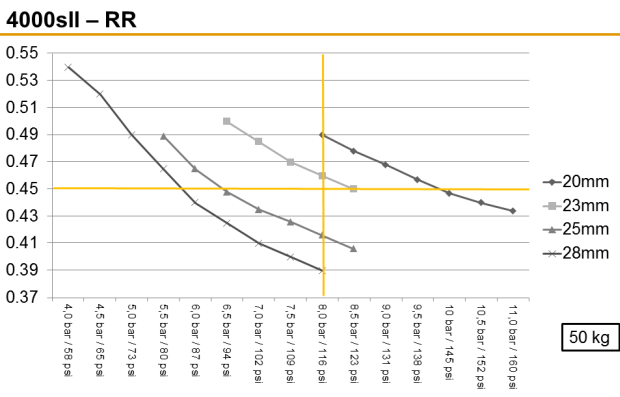It will never happen, but with rim widths varying so much these days, the designations "23mm," "25mm," "28mm," etc. just are not that meaningful anymore.
What would be a lot more helpful would be for tires sizes to be listed by their cross section measured bead-to-bead ("B2B") out of the box and laid flat. I'm sure some tires inflate "higher" or "wider" than others given a particular B2B, but I doubt there is much variation due to "inflated shape" and you can pretty safely assume that a tire with a wider B2B will result in a wider inflated tire (rather than simply a "taller" tire and yes that is despite what we know about the GP4000SII and its "magic aero" properties). And of course a tire with a given B2B will result in a wider inflated tire when mounted on a wider rim (internal bead width).
Below is a list from a thread on the Internets showing exactly this, the B2B of a variety of tires. You can see that for various "23mm" tires, the B2B can vary from as narrow as 56mm to as wide as 60mm. And then you have some "24mm" tires that measure as wide as 64mm. So you can have an 8mm swing just moving from a "23mm" tire to a "24mm" tire. And then of course these tires will all measure out quite differently when mounted on different width rims.
So what we really need is tires listed in B2B, and then for the rim/wheel manufacturers (or Slowtwitchers armed with their digital calipers) to tell us what range of B2B works best for a particular rim's width (both external and internal). Generally speaking, we would expect the "ideal" B2B to be the B2B that results in the measured width of the inflated tire equaling 95% of the external rim width. This way, we are obeying the Rule of 105 while at the same time using the widest tire for lowest rolling resistance.
OK fine, we all know tire manufacturers are not going to give up on the "23mm-25mm-28mm" designations in the same way that we know they are not going to stop reporting aero results in terms of "watts saved" because in both cases these are measurement units that consumers can get their heads around - a lot more than B2B and CdA. But if we can get manufacturers to report CdA
in addition to "watts saved," can we get manufacturers to report B2B
in addition to "23mm-25mm-28mm?" It's a lot more informative.
| Mfr | Size | Model | B2B |
--------------------------------------------------------------------------------------------------
|
Bontrager | 700X23 | Race X Lite Silica | 60 |
--------------------------------------------------------------------------------------------------
| Clement | 700X28 | Strada LGG | 68 |
--------------------------------------------------------------------------------------------------
| Continental | 700X24 | Grand Prix | 64 |
--------------------------------------------------------------------------------------------------
| Continental | 700X25 | GP4000s | 70 |
--------------------------------------------------------------------------------------------------
| Continental | 700X22 | GP Attack | 54 |
--------------------------------------------------------------------------------------------------
| Continental | 700X23 | GP3000 | 58 |
--------------------------------------------------------------------------------------------------
| Continental | 700X23 | Force | 57 |
--------------------------------------------------------------------------------------------------
| Deda | 700X23 | TRE RS | 58 |
--------------------------------------------------------------------------------------------------
| Hutchinson | 700X23 | Fusion 2 Triathalon | 59 |
--------------------------------------------------------------------------------------------------
| Michelin | 700X23 | Speedium 2 | 64 |
--------------------------------------------------------------------------------------------------
| Michelin |
700X25 | Pro4 Race SC | 70 |
--------------------------------------------------------------------------------------------------
| Michelin | 700X23 | Pro4 Race SC | 60 |
--------------------------------------------------------------------------------------------------
| Michelin | 700X23 | Pro3 Race SC | 60 |
--------------------------------------------------------------------------------------------------
| Michelin | 700X25 | Krylion | 72 |
--------------------------------------------------------------------------------------------------
| Michelin | 700X25 | Pro3 Race SC | 72 |
--------------------------------------------------------------------------------------------------
| Michelin | 700X23 | Krylion | 64 |
--------------------------------------------------------------------------------------------------
| Michelin |
700X25 | Pro Optimum | 72 |
--------------------------------------------------------------------------------------------------
| Michelin | 700X23 | Pro4 Endurance | 59 |
--------------------------------------------------------------------------------------------------
| Panaracer | 700X23 | Type-A | 56 |
--------------------------------------------------------------------------------------------------
| Schwalbe | 700X28 | One Tubeless | 77 |
--------------------------------------------------------------------------------------------------
| Specialized | 700X23 | Pro all conditions | 56 |
--------------------------------------------------------------------------------------------------
| Vittoria | 700X24 | Diamante Pro Radiale | 64 |
--------------------------------------------------------------------------------------------------
| Vittoria | 700X24 | Open Pave Evo | 64 |
--------------------------------------------------------------------------------------------------
| Vittoria | 700X23 | Rubino Pro 3 | 60 |
--------------------------------------------------------------------------------------------------
| WTB | 700X23 | Camino Alto | 59 |
The last number for each is the measured B2B.
Amateur recreational hobbyist cyclist
https://www.strava.com/athletes/337152 https://vimeo.com/user11846099









